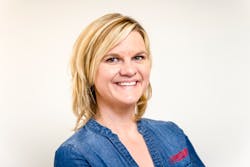Forging Communication Between Customers and Insurance Companies
All body shops have to forge communication between customers and insurance companies. And at All Line CARSTAR in Bolingbrook, Ill., Courtney Hartwell is the middle woman.
As an estimator for All Line CARSTAR, the pressure is on her to both balance a satisfactory customer experience and maintain the shop’s DRPs. And Hartwell is living proof that the most crucial component of building that bridge isn’t an extensive background in collision repair, but instead an organized schedule and established communication skills.
“I think anybody can do it,” Hartwell, who managed a tanning salon before settling in at All Line CARSTAR, says. “There's a lot of different levels of things you need to make sure are checked off a list properly. I think anybody could become an appraiser and do their job very well. You don't have to have the knowledge—it's all stuff you can learn. But you have to be willing to learn it and educate yourself.”
And that’s exactly what Hartwell did. In the 11 years she’s worked at All Line CARSTAR, Hartwell has built her estimating expertise, earning I-CAR Gold status and ASE certification.
These days, Hartwell has the estimating process mastered, and her success stems from a tried-and-true inspection and communication process that keeps customer satisfaction high and stress levels low.
SHOP STATS
All Line CARSTAR
Bolingbrook, Ill.
Size: 18,000 square feet
Staff: 18 (5 body technicians, 2 painters, 2 detailers, 2 estimators, 1 fast lane tech, 1 DFR/mechanic, 1 production manager, 1 parts manager, 1 office manager, 1 CSR, 1 operations manager)
Monthly Car Count: 170
Annual Revenue: $3.5 million
Our shop has over 25 direct repair relationships with insurance companies in which we essentially serve as their estimator. We probably work with 10 that write their own estimates, but we know what parts they use just based on doing the work for them. I pretty much know the guidelines based on having done enough work for them and what they require.
I follow a pattern with inspections. If you can write everything at once, it makes it easier on the insurance side, makes it easier for the customer, because at that point you're ordering all the parts at one time for all the damage. You get all the parts in at the same time, you process the repairs quicker—in the ideal world.
In the industry right now, especially in the Midwest with the weather we get, we have to schedule. So you can only see what you can see with the vehicle being driven, and then once that car's washed, it's amazing the additional items you find. Then you go from there. You're on the floor, looking under hoods, pulling bumpers back, pulling out lights. Technicians will do all that for me, but I’m the one photographing it, writing what's needed and going from there.
There’s so many new electronics that a lot of times I have to educate myself. Once this car is done: What lights could be on that need to be checked? What systems need to be reset? Maybe a blind spot indicator? A lot of times there are certain things that have to have a company reset them and make sure all those things function properly. Even if you're just removing a bumper and putting a bumper back on, they're more technical and more involved now than they were. You have to know all that. You have to have the education.
We do quality control on our own vehicles and, as an estimator, I make sure that the expectation we set with customers at the time of writing the estimate is met when we go to deliver that vehicle. Often we're back at the car with the customer when they pick it up to go over exactly what we’ve done in the repair plan and the finished vehicle itself. So it's a hectic day.
I'm the one that opens our facility. By the time we open our doors at 7 a.m., we have scheduled repairs that are coming in and we help get them in their rental cars, get their vehicles in. Our facility goes through a mapping process.
When the car is dropped off and washed, as an estimator, I go to the car and map out what we're repairing, replacing, removing, reinstalling. I check the car for any prior damage and then I schedule an estimate.
My schedule depends on our workload that day. We have customers that will be scheduled, and we have estimates that I'll write. So you're filtering estimates that you'll write, as well as updating and working with your current repairs that are in the shop. Then you have time allowed for following up on unfilled estimates or updating people in general.
I use a half-hour time plan. So when I come in in the morning, I already know what my day is going to look like. I have an estimate at 8 a.m.; at 8:30, I have something blocked to do with a technician or review a car; maybe at 9, we do a meeting. Then after lunch, I might have three estimates in the afternoon, and then I might have time saved to work on cars that have additional repairs or damage found that I've got to add to the management system and go over with the technician.
I block time to review jobs with customers or finish files for cars going that day. If you have a car come in that's towed in and not drivable, we can go into our own schedule and figure out a day that's open that will allow us to address it.
Communication is huge on all levels. Communication within the shop between all the departments; communication with your customer; communication with insurance. Customers are inconvenienced in an accident. Nobody wants it, nobody expects it, and a lot of the time, they’ve never done that before and they don't know how to handle it.
To be an estimator, I think you have to understand the position is extremely stressful, just based on the expectation. You're trying to please the customer, and you're trying to make sure you're doing what the insurance carriers require.
Explaining that process to customers is the hardest part. I try to explain the communication process between us and the insurer as best I can. If the customer has never done this, they don’t understand how long the process takes, how the estimate changes, etc. So it’s really up to me to educate them.
When I talk with customers, I make sure I update them with where the car is in the repair process, so they know I care, and that their car is not just another car in our repair process. I like to get to know them a little bit, so we’ll banter, but I also make sure that the conversation is ultimately about their car. They want information. They will usually get at least one update from me, and more if it’s behind schedule. So, the more you communicate and inform them and keep them educated, I think you build trust with them. A car is an investment, and you're taking care of that investment for people.
I think if you’re negative and you really don’t listen to a customer, you’re setting yourself up for disaster. If the customer has a concern with the estimate, the only thing we can do is address it with the insurer and let them make that decision because that's why they are who they are.
I know everybody tries to portray insurance companies as not taking care of their customers, but they really do take care of people when they need to, and they make sure that they really pay what's really owed to a customer.
Being organized is the root of easing the stress. I schedule when I’ll call customers or reach to insurance companies for updates, making sure I cover both ends of an inherently stressful communication process and cover that gap between them. I think if you build a really good relationship with your insurance companies, that makes the communication process easier.
The process in general makes it less stressful because you know you're trying to do, as a whole, what's best for the customer.

